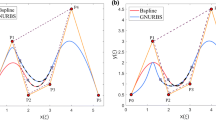Abstract
The gap between finite element analysis and computer-aided design derives the development of isogeometric analysis (IGA), which uses the same representation in the geometry and the analysis. However, the parameterization in IGA is non-trivial. Weighted extended B-splines (WEB) method replaces grid generation and parameterization with weight function construction (R-function or distance function). By using implicit spline representation, isogeometric analysis on implicit domains (IGAID) adopts the merits of the “isoparametric” in IGA and “weight function generation” in WEB. But the theoretical properties have not been fully studied yet. In this paper, we study the theoretical aspects of IGAID using tensor-product B-splines. Both the approximation and stability properties of IGAID are considered. By setting appropriate constraints on the weight function, we can derive the optimal approximation order and stability. Numerical examples show the effectiveness of the approach and validate the theoretical results.










Similar content being viewed by others
References
Auricchio, F., Beirao da Veiga, L., Buffa, A., Lovadina, C., Reali, A., Sangalli, G.: A fully locking-free isogeometric approach for plane linear elasticity problems: a stream function formulation. Comput. Methods Appl. Mech. Eng. 197, 160–172 (2007)
Bézier, P.: Numerical Control-Mathematics and Applications. Wiley (1972)
Brenner, A.C., Scott, L.R.: The Mathematical Theory of Finite Element Methods, 3rd edn. Springer, New York (2000)
Buffa, A., Sangalli, G., Vázquez, R.: Isogeometric analysis in electromagnetics: B-splines approximation. Comput. Methods Appl. Mech. Eng. 199, 1143–1152 (2010)
Cottrell, J.A., Reali, A., Bazilevs, Y., Hughes, T.J.R.: Isogeometric analysis of structural vibrations. Comput. Methods Appl. Mech. Eng. 195, 5257–5296 (2006)
Cottrell, J.A., Hughes, T.J.R., Bazilevs, Y.: Isogeometric Analysis: Toward Integration of CAD and FEA. Wiley (2009)
Deng, F., Zeng, C., Deng, J.S.: Boundary-mapping parametrization in isogeometric analysis. Commun. Math. Stat. 4, 203–216 (2016)
Höllig, K.: Finite Element Methods with B-Splines. Society for Industrial and Applied Mathematics (2003)
Höllig, K., Reif, U., Wipper, J.: Weighted extended B-spline approximation of Dirichlet problems. SIAM J. Numer. Anal. 39, 442–462 (2001)
Hughes, T.J.R., Cottrell, J.A., Bazilevs, Y.: Isogeometric analysis: CAD, finite elements, NURBS, exact geometry and mesh refinement. Comput. Methods Appl. Mech. Eng. 194, 4135–4195 (2005)
Li, X., Sederberg, T.W.: S-splines: a simple surface solution for IGA and CAD. Comput. Methods Appl. Mech. Eng. 350, 664–678 (2019)
Liu, Y., Song, Y., Yang, Z., Deng, J.S.: Implicit surface reconstruction with total variation regularization. Comput. Aided Geom. Des. 52, 135–153 (2017)
Liu, H., Yang, Y., Liu, Y., Fu, X.: Simultaneous interior and boundary optimization of volumetric domain parameterizations for IGA. In: Computer Aided Geometric Design, p. 79 (2020)
Martin, T., Cohen, E., Kirby, M.: Volumetric parametrization and trivariate b-spline fitting using harmonic functions. Comput. Aided Geom. Des. 26, 648–664 (2009)
Martin, T., Cohen, E.: Volumetric parametrization of complex objects by respecting multiple materials. Comput. Graph. 34, 187–197 (2010)
Qarariyah, A., Deng, F., Yang, T., Liu, Y., Deng, J.S.: Isogeometric analysis on implicit domains using weighted extended PHT-splines. J. Comput. Appl. Math. 350, 353–371 (2019)
Rvachev, V.L., Sheiko, T.I.: R-functions in boundary value problems in mechanics. Appl. Mech. Rev. 48, 151–188 (1995)
Shapiro, V.: Theory of R-Functions and Applications: A Primer, Technicalreport CPA88-3. Cornell Programmable Automation, Sibley School of Mechanical Engineering, Ithaca, New York (1988)
Takacs, T., Jüttler, B.: Existence of stiffness matrix integrals for singularly parameterized domains in isogeometric analysis. Comput. Methods Appl. Mech. Eng. 200, 3568–3582 (2011)
Wei, X., Li, X., Qian, K., Hughes, T.J.R., Yongjie, J.Z., Hugo, C.: Analysis-suitable unstructured T-splines: Multiple extraordinary points per face. Comput. Methods Appl. Mech. Eng. 391, 114494 (2022)
Xu, J., Chen, F., Deng, J.S.: Two-dimensional domain decomposition based on skeleton computation for parametrization and isogeometric analysis. Comput. Methods Appl. Mech. Eng. 284, 541–555 (2015)
Xu, G., Mourrain, B., Duvigneau, R., Galligo, A.: Variational harmonic method for parametrization of computational domain in 2D isogeometric analysis. In: 12th International Conference on Computer-Aided Design and Computer Graphics, pp. 223–228 (2011)
Xu, G., Mourrain, B., Duvigneau, R., Galligo, A.: Parametrization of computational domain in isogeometric analysis: methods and comparison. Comput. Methods Appl. Mech. Eng. 200, 2021–2031 (2011)
Acknowledgements
The work is supported by the National Natural Science Foundation of China (Nos. 12171453 and 12001197).
Author information
Authors and Affiliations
Corresponding author
8 Appendix
8 Appendix
1.1 A. The Proof of Theorem 4.1
Proof
We prove Eq. 4.2 first.
By Eq. 3.2, \(B_i=\frac{w(x)}{w(x_i)}{\tilde{b}}_i=\frac{w(x)}{w(x_i)}(b_i+\sum \limits _{j\in J(i)}e_{ij}b_j),\) we have
Then, we prove Eq. 4.3,
We have
Last, we prove Eq. 4.4
\(\square \)
1.2 B. The Proof of Theorem 4.2
Proof
We only give the proof of Eq. 4.5, Eq. 4.6 can be proved similarly.
Therefore, \(\left\| \sum \limits _{i \in I}\alpha _iB_i\right\| _0\le \left( \max \limits _{i\in I}||B_i||_0\right) ||A||.\) \(\square \)
1.3 C. The Proof of Theorem 4.3
Proof
Let \(wp = \sum \limits _{i\in I} \alpha _i B_i\), times \(\wedge _j\) and integral lead to
then
\(\square \)
1.4 D. The Proof of Lemma 5.1
Proof
We prove the first inequation.
\(\frac{w(x)}{w(x_i)}=1+\frac{w(x)-w(x_i)}{w(x_i)}\), by the smoothness of w and the boundness of \(|\nabla w|\), we have
If \(\textrm{dist}(x_i,\partial \Omega )>\delta ,\) using Fact 2, we have \(w(x_i)\ge c_3, \) therefore,
If \(\textrm{dist}(x_i,\partial \Omega )\le \delta ,\) using Fact 1, we have
Therefore,
Then, we prove the second inequation.
As \(x\in \sup (\wedge _i),\) we have \(\hbox {dist}(x,\partial \Omega )\succeq h\). Similar discussion as Lemma 5.1, we have
\(\frac{w(x_i)}{w(x)}=1+\frac{w(x_i)-w(x)}{w(x)}\), by the smoothness of w and the boundedness of \(|\nabla w|\), we have
If \(\hbox {dist}(x,\partial \Omega )>\delta ,\) using Fact 2, we have \(w(x)\ge c_3. \) Therefore,
If \(\hbox {dist}(x,\partial \Omega )\le \delta ,\) using Fact 1, we have
Therefore,
\(\square \)
Rights and permissions
About this article
Cite this article
Deng, F., Yang, T., Liu, J. et al. Isogeometric Analysis on Implicit Domains: Approximation, Stability and Error Estimates. Commun. Math. Stat. (2023). https://doi.org/10.1007/s40304-022-00307-5
Received:
Revised:
Accepted:
Published:
DOI: https://doi.org/10.1007/s40304-022-00307-5




